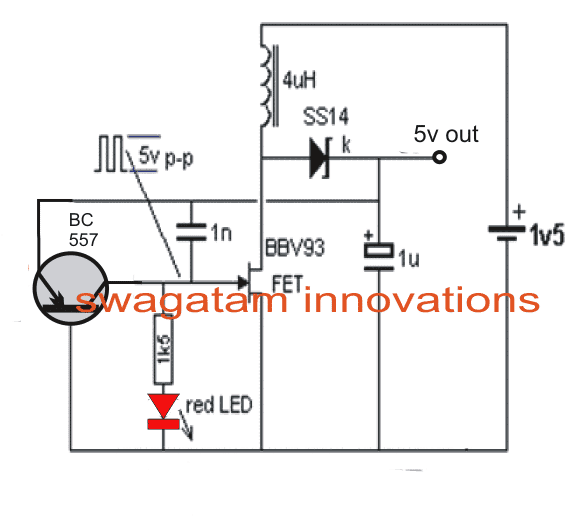In this post I have explained a very simple charging a cell phone from a 1.5v battery utilizing merely a 1.5V as the input source. The source can be any 1.5V cell rated at minimum 1000 mAH.
Circuit Operation
The circuit description is provided below, let's try to understand the working principle of the proposed cell phone charger circuit using a 1.5V source.
The circuit of a phone charger bears a simple design, with two surface-mount transistors, an inductor, diode, resistor and LED.
However, it should be noted that, one transistor acts as a controller while the other as FET. As the controller gets power from the output (5v) of the circuit, and detecting no-load; the same shuts down.
Moreover it requires very less current. Connecting the 1v5 battery, the controller initiates using less than 1v5 because of the Schottkey diode, charging the 1uF capacitor with the use of FET and flyback effect of the inductor; thus producing high voltage.
With the voltage of output set to 5v, the controller goes in ‘Off’ state, and the only load managed by the 1uF is the controller. As the voltage falls across the capacitor, the controller turns on in bursts, thereby charging the 1uF to 5v.
The method of charging a cell phone from a 1.5v battery is very cheap and can be made at as low as $3, and it also comes with 4 adapter leads.
Submitted By: Dhrubajyoti Biswas
Circuit Diagram



HI Can you show bulding this Circuit step by step and with the Pic of the components
Dear,
I prepared this circuit after understanding its concept and it worked well, but with some modifications done;
1. i used 3v as input supply. i also added a 330u 25v cap at input rail.
2. i made the circuit keeping the 1uf cap temporarily disconnected, i got a no-load voltage of 19v(18.93 on dmm)
3. i used 2 2n7000 fets parallel in circuit.
4. i used toroidal inductor with 10t of normal solid wire.
5. i removed led and resistor, connected to o/p rail.
6. i used a 10u35v cap at o/p in place of 1u.
7. i added a zener and resistor network to give 5v.
now i got 5.13 volts.
8. finally, i added a 10u35v tantalum and the whole circuit is now complete.
Thanks, sir for this basic circuit design,
Your circuits are really helpful.
Now i can call it my own power bank circuit.
Regards
Dear Sherwin, that's very impressive, thanks for updating the info….and if it's possible you can send the pics of your circuit for publishing, ….only if it's extremely convenient
Dear,
1. Using a duracell, what could be the efficiency of the circuit?
2. Could i use a toroidal core for the inductor since i have them on hand? Is the inductance value crucial here?
3. What changes should i make if i use 3v as input supply?
Thanks.
Dear, the above circuit has not been tested by me, so I can't suggest much about it… I would rather recommend you to try the following circuit instead:
https://www.homemade-circuits.com/2012/10/1-watt-led-driver-using-joule-thief.html
Hello dear,
what type of diode is ss14?
plese help.
hello Sherwin, it's a fast recovery, zero drop type of diode
Hi Dear swagatham,
can I use BAT54 Schottkey diode or any other in place of SS14?
Dear Won,
Actually I have not tested this circuit so not very sure, you can try the part and check how it functions
OK Dear I'll,thank you very much! I really like your works and your kindness to give an answer for everyone's question!
Good job…!
The pleasures's all mine:)
BBV93 BF245A equivalent
both are n-channel fets, so might work as a replacement
Dear
Can you give some more detail about inductor for correct purchase?
Thank you
It has to be hand made, it might not be available in the market.
both are n-channel fets, so it might work
BBV93 BF245A equivalent